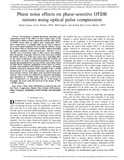Mostrar el registro sencillo del ítem
Phase noise effects on phase-sensitive OTDR sensors using optical pulse compression
| dc.creator | Loayssa Lara, Alayn | es_ES |
| dc.creator | Sagüés García, Mikel | es_ES |
| dc.creator | Eyal, Avishay | es_ES |
| dc.date.accessioned | 2022-04-26T12:50:00Z | |
| dc.date.available | 2022-12-24T00:00:11Z | |
| dc.date.issued | 2021 | |
| dc.identifier.citation | A. Loayssa, M. Sagues and A. Eyal, 'Phase Noise Effects on Phase-Sensitive OTDR Sensors Using Optical Pulse Compression,' in Journal of Lightwave Technology, vol. 40, no. 8, pp. 2561-2569, 15 April15, 2022, doi: 10.1109/JLT.2021.3138249. | en |
| dc.identifier.issn | 0733-8724 | |
| dc.identifier.uri | https://hdl.handle.net/2454/42807 | |
| dc.description.abstract | We introduce a detailed theoretical, numerical, and experimental study of the effects of laser's phase noise on the performance of phase-sensitive optical time-domain reflectometry (-OTDR) sensors that use optical pulse compression (OPC). Pulse compression is a technique that can be used to improve the received signal amplitude by increasing the effective energy of the pulses that are launched into the fiber without degrading the spatial resolution of the measurements. Therefore, it is a valuable tool to extend the range of these sensors and mitigate fiber attenuation constraints. However, it has been observed that the limited coherence of the laser source has a degrading effect on the actual performance enhancement that this method can provide. Here, we derive a theoretical model that can be used to quantify this degradation for any type of OPC such as those based on either linear frequency modulation (LFM) pulses or perfect periodic autocorrelation (PPA) bipolar bit sequences. The model facilitates numerical estimation of the sensitivity of the -OTDR measurements. It also produces theoretical expressions for the mean and the variance of the phase-noise perturbed backscatter response. These results are validated via numerical simulations and experiments in -OTDR setups using LFM as well as PPA OPC. Furthermore, we demonstrate the use of the model to investigate the basic trade-offs involved in the design of OPC -OTDR systems. | en |
| dc.description.sponsorship | This work is part of the project PDC2021-121172-C21 funded by MCIN/AEI/10.13039/501100011033 and European Union ‘Next generationEU’/PRTR, and of project PID2019- 107270RB, funded by MCIN/AEI/10.13039/501100011033 and FEDER ‘A way to make Europe’. The work was supported in part by the Israeli Science Foundation (ISF), grant number 2675/20. | en |
| dc.format.extent | 9 p. | |
| dc.format.mimetype | application/pdf | en |
| dc.language.iso | eng | en |
| dc.publisher | IEEE | en |
| dc.relation.ispartof | Journal of Lightwave Technology vol. 40, no. 8, April 15, 2022 | en |
| dc.rights | © 2021 IEEE. Personal use of this material is permitted. Permission from IEEE must be obtained for all other uses, in any current or future media, including reprinting/republishing this material for advertising or promotional purposes, creating new collective works, for resale or redistribution to servers or lists, or reuse of any copyrighted component of this work in other work | en |
| dc.subject | Distributed acoustic Sensing | en |
| dc.subject | Laser noise | en |
| dc.subject | Linear frequency modulation | en |
| dc.subject | Nonlinear optics | en |
| dc.subject | Optical pulse compression | en |
| dc.subject | Optical sensors | en |
| dc.subject | Optical time domain reflectometry | en |
| dc.subject | Optical variables measurement | en |
| dc.subject | Perfect periodic autocorrelation codes | en |
| dc.subject | Phase noise | en |
| dc.subject | Sensors | en |
| dc.title | Phase noise effects on phase-sensitive OTDR sensors using optical pulse compression | en |
| dc.type | info:eu-repo/semantics/article | en |
| dc.type | Artículo / Artikulua | es |
| dc.contributor.department | Institute of Smart Cities - ISC | es_ES |
| dc.contributor.department | Ingeniería Eléctrica, Electrónica y de Comunicación | es_ES |
| dc.contributor.department | Ingeniaritza Elektrikoa, Elektronikoa eta Telekomunikazio Ingeniaritza | eu |
| dc.rights.accessRights | info:eu-repo/semantics/openAccess | en |
| dc.rights.accessRights | Acceso abierto / Sarbide irekia | es |
| dc.embargo.terms | 2022-12-24 | |
| dc.identifier.doi | 10.1109/JLT.2021.3138249 | |
| dc.relation.projectID | info:eu-repo/grantAgreement/AEI/Plan Estatal de Investigación Científica y Técnica y de Innovación 2017-2020/PID2019-107270RB-C22/ES/ | en |
| dc.relation.publisherversion | https://doi.org/10.1109/JLT.2021.3138249 | |
| dc.type.version | info:eu-repo/semantics/acceptedVersion | en |
| dc.type.version | Versión aceptada / Onetsi den bertsioa | es |





